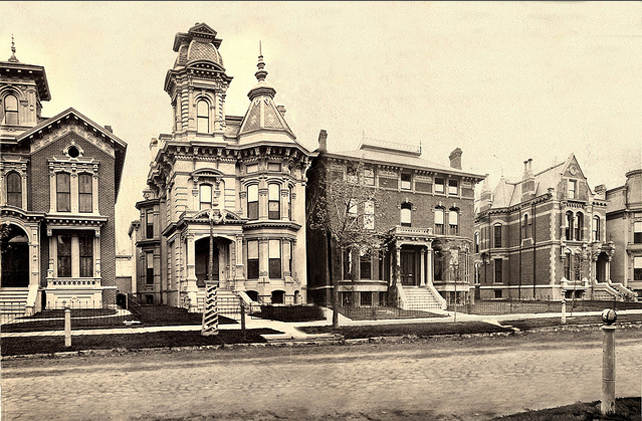[[Unknown photographer) Fairy-tale palaces for the well-to-do in the Paris of the Midwest, on Alfred Street in Brush Park in Detroit in 1881. It was all a fantastic dream, a stage-set for Victorian manners and unimaginable prosperity without end, a gilded age, the product of the settlement of the far West, of the overreaching railroads and steamships … and of millions of highly skilled immigrants from Europe.
Brush Park was a psychedelic dream-scape of hundreds of extravagant, gilded mansions, with hundreds more throughout the city: not so much an idea but an escape from the necessity of having to think about anything at all. It was as if the prosperity wasn’t real but needed physical manifestations, each more outlandish than the next … to reassure those with the most that most was indeed what they had.
______________________________
After the war, whites who could fled the city for the ballooning suburbs, a period of migration that lasted for decades. Cities are made and broken by flows of capital and human beings. Detroit originally grew and took form from the incoming tide of European immigrants who built in the manner and with the materials they were familiar. The craftsmen who built the fairy castles were replaced with unskilled agricultural workers looking to toil in the expanding automobile factories, these workers had no background or interest in city-building. They needed a paycheck, the city would take care of itself.
Instead, big business ‘took care’ of the city. Beginning in 1908 came the machines: the city was steadily made over as an auto habitat.
http://www.economic-undertow.com/2012/12/09/the-string-economy/
Detroit was doomed from the very beginning. It did have a heyday in the late 1900s, when the rest of the US was suffering through the 'Long Depression'. Afterward, the age of the craftsman ended leaving the age of chain link and asphalt.
Results 1 to 25 of 51
Thread: Root cause of problems?
Hybrid View
-
March-22-13, 10:19 PM #1
 DetroitYES Member
DetroitYES Member
- Join Date
- Dec 2012
- Posts
- 42

Welcome to DetroitYES! Kindly Consider Turning Off Your Ad BlockingX
DetroitYES! is a free service that relies on revenue from ad display [regrettably] and donations. We notice that you are using an ad-blocking program that prevents us from earning revenue during your visit.
Ads are REMOVED for Members who donate to DetroitYES! [You must be logged in for ads to disappear]
Ads are REMOVED for Members who donate to DetroitYES! [You must be logged in for ads to disappear]
DONATE HERE »
And have Ads removed.
And have Ads removed.








 Reply With Quote
Reply With Quote


Bookmarks